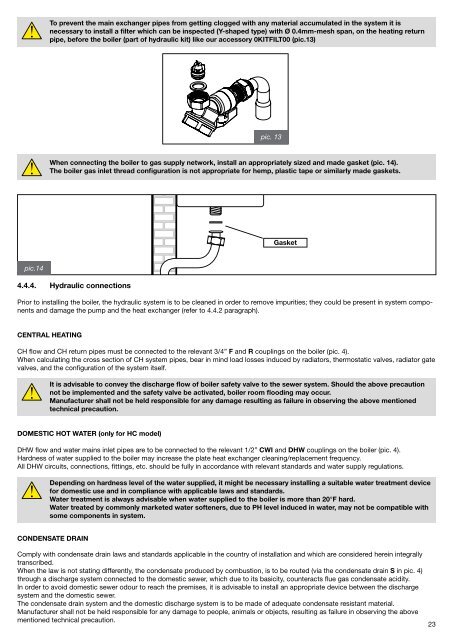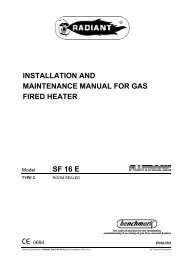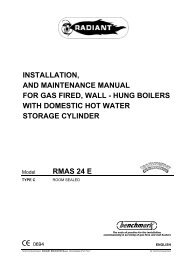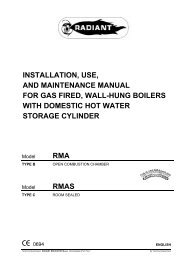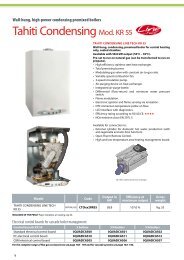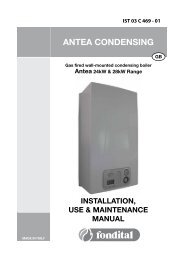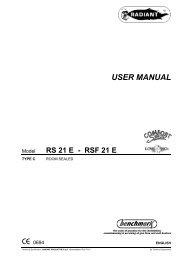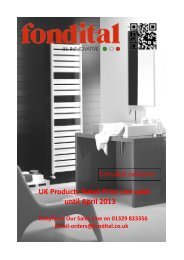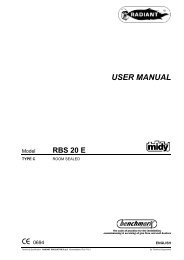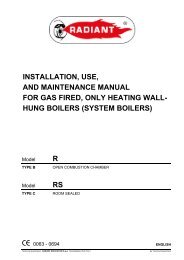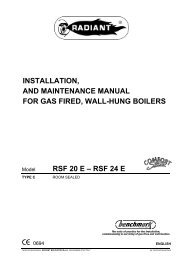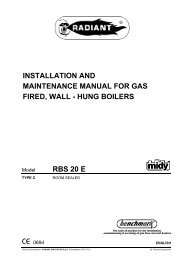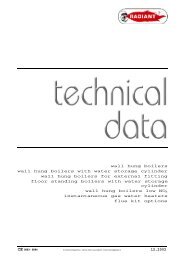TAHITI DUAL HC - HR - Portsdean Technical
TAHITI DUAL HC - HR - Portsdean Technical
TAHITI DUAL HC - HR - Portsdean Technical
Create successful ePaper yourself
Turn your PDF publications into a flip-book with our unique Google optimized e-Paper software.
To prevent the main exchanger pipes from getting clogged with any material accumulated in the system it is<br />
necessary to install a filter which can be inspected (Y-shaped type) with Ø 0.4mm-mesh span, on the heating return<br />
pipe, before the boiler (part of hydraulic kit) like our accessory 0KITFILT00 (pic.13)<br />
pic. 13<br />
When connecting the boiler to gas supply network, install an appropriately sized and made gasket (pic. 14).<br />
The boiler gas inlet thread configuration is not appropriate for hemp, plastic tape or similarly made gaskets.<br />
Gasket<br />
pic.14<br />
4.4.4. Hydraulic connections<br />
Prior to installing the boiler, the hydraulic system is to be cleaned in order to remove impurities; they could be present in system components<br />
and damage the pump and the heat exchanger (refer to 4.4.2 paragraph).<br />
CENTRAL HEATING<br />
CH flow and CH return pipes must be connected to the relevant 3/4” F and R couplings on the boiler (pic. 4).<br />
When calculating the cross section of CH system pipes, bear in mind load losses induced by radiators, thermostatic valves, radiator gate<br />
valves, and the configuration of the system itself.<br />
76<br />
It is advisable to convey the discharge flow of boiler safety valve to the sewer system. Should the above precaution<br />
not be implemented and the safety valve be activated, boiler room flooding may occur.<br />
Manufacturer shall not be held responsible for any damage resulting as failure in observing the above mentioned<br />
technical precaution.<br />
DOMESTIC HOT WATER (only for <strong>HC</strong> model)<br />
DHW flow and water mains inlet pipes are to be connected to the relevant 1/2” CWI and DHW couplings on the boiler (pic. 4).<br />
Hardness of water supplied to the boiler may increase the plate heat exchanger cleaning/replacement frequency.<br />
All DHW circuits, connections, fittings, etc. should be fully in accordance with relevant standards and water supply regulations.<br />
Depending on hardness level of the water supplied, it might be necessary installing a suitable water treatment device<br />
for domestic use and in compliance with applicable laws and standards.<br />
Water treatment is always advisable when water supplied to the boiler is more than 20°F hard.<br />
Water treated by commonly marketed water softeners, due to PH level induced in water, may not be compatible with<br />
some components in system.<br />
CONDENSATE DRAIN<br />
Comply with condensate drain laws and standards applicable in the country of installation and which are considered herein integrally<br />
transcribed.<br />
When the law is not stating differently, the condensate produced by combustion, is to be routed (via the condensate drain S in pic. 4)<br />
through a discharge system connected to the domestic sewer, which due to its basicity, counteracts flue gas condensate acidity.<br />
In order to avoid domestic sewer odour to reach the premises, it is advisable to install an appropriate device between the discharge<br />
system and the domestic sewer.<br />
The condensate drain system and the domestic discharge system is to be made of adequate condensate resistant material.<br />
Manufacturer shall not be held responsible for any damage to people, animals or objects, resulting as failure in observing the above<br />
mentioned technical precaution.<br />
23


